Sapa is located in the Lào Cai Province of Vietnam and is a region that draws visitors from across the world. The town is situated on the side of one of the many mountains in the massive Hoàng Liên Son mountain range. It overlooks the valley below. The valley floor is filled with rice terraces that change from bright green to yellow depending on the time of year that you visit.
Most people visit Sapa to immerse themselves in the gorgeous landscape through trekking expeditions as the roads aren’t great and there are well-maintained footpaths. Trekking is definitely the best way to explore the region of Sapa, Vietnam.
Read on to learn all about what to do, where to stay, and how to book with this guide to trekking in Sapa!
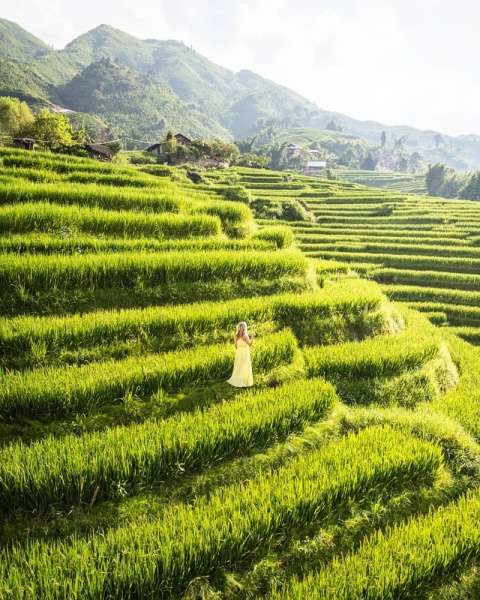
Page Contents
ToggleTrekking in Sapa Guide
If you want to go trekking in Sapa with a local Hmong guide, we highly recommend our good friend A Hang Thi.
Disclaimer: This post may contain affiliate links. If you make a purchase or booking through one of our links we may earn a small commission (don’t worry, it’s at no extra cost to you).
Sapa Travel Basics
Getting to Sapa
The town of Sapa is about 200 miles north of Hanoi. You can either hire a driver, which will be pricey, take a bus (which we recommend), or take a sleeper train. Sapa Express is by far the best bus operator as it has clean, comfortable buses with safe drivers. They generally leave right on time. It’s super easy to book your bus or train tickets ahead of time on Bookaway!
You can choose the 7 am bus with spacious seats (called the “Limousine Bus”) or the later times that offer beds. We found the seated option to be far more comfortable than the beds, especially for people who are tall or who have mobility issues.
As soon as you get off the bus in the center of town, you will be bombarded by Hmong women wanting to sell you their wares or offer you a trekking tour to their village. So you don’t necessarily need to book a trekking tour ahead of time unless you really want to.
Weather in Sapa
The weather in the Sapa region varies widely by season. In the summer months, it is considered subtropical and often experiences heavy rainfall. The weather in the winter is moderate, even chilly, and can even snow high in the mountains. July and August are the warmest months, and also the rainiest. The coldest months are December and January.
The wet season is from May to September, and although it can be rainy and miserable at times. This is when the rice paddies are their brightest green.
Planning Your Visit to Sapa
Depending on your preference, you can either plan your entire trekking in Sapa trip ahead of time. Or, you can get on the bus and wing it once you get there. Either is completely doable, it just depends on your preference and how much flexibility you have in your Vietnam itinerary.
There is no real need to book a trekking tour in advance as you’ll be approached by Hmong ladies as soon as you arrive, offering to guide you on a trek. You can choose to do a day trip or a multi-day trip in which case your homestays will be included in the tour.
If you have time, we would recommend booking your first or two nights in Sapa town so you can visit Cat Cat village and Fansipan mountain. Then, schedule a 2-day trekking tour with a local guide. Finally, spend a few nights in one of the smaller towns nearby to relax and unwind.
What to Pack for Sapa
There are countless stores in Sapa town (and all over Vietnam) hawking knock-off trekking gear. You can find anything and everything you’ll need for a trekking excursion. The only issue with relying on this gear is that it isn’t necessarily good quality. You don’t want to end up with a soleless hiking boot mid-hike!
If you do decide to pick up a jacket or backpack in Sapa, you’ll find much cheaper prices at the Sapa Market compared to the shops in the center of town. But you’ll need to haggle.
Pack a pair of comfortable hiking shoes that have a lot of traction and will keep your feet dry if you get caught hiking in a downpour. Throw a lightweight, compact, and water-resistant jacket in your bag. If you visit during the winter months, pick up a few pairs of water-resistant, fleece-lined leggings to keep you toasty. Don’t forget a small day-pack if you plan on doing a multi-day trek. You can leave your larger bags at your hotel.
Complete Guide to Trekking in Sapa, Vietnam
Things to do in the Town of Sapa
As tourism in the area has increased, so has the infrastructure in the town of Sapa. It is now filled with hotels, shops, restaurants, and bars. It can be difficult to walk around the town as sidewalks are few and far between. But, it’s likely that will change in the coming years.
Sapa town is lively but it is also incredibly touristy. It is filled with backpackers who are being followed by Hmong ladies dressed in traditional attire, trying to get them to purchase their handmade woven treasures. If you are looking for a more tranquil, authentic experience, you may want to stay in one of the nearby villages like Lao Chai or Ta Van.
Hồ Sa Pa Lake
Most foreigners come to Sapa for the sole purpose of trekking. But there are a few things you can do if you have extra time in the town. The first (and free) activity is to have a stroll around Hồ Sa Pa Lake around sunset for beautiful mountain views. It’s also a bustling area in the evenings and a great place to people-watch.
Shopping in Sapa Market
There is no lack of shopping in Sapa and you will be constantly bombarded by locals on the street showing you their wares. For the best selection and prices, you should head to the New Sapa Market (“Cho Sa Pa”) located ~1/2 mile east of Hồ Sa Pa Lake. On the second floor, you’ll find rows of women selling both new and second-hand textiles from the local communities.
AD
Bac Ha Market is the most popular market in the area as all of the minority groups in the area come together to sell their wares here. It takes place on Sundays and is about a 2.5-hour drive outside of town. Many tourists add this market to their guided tours. Or, you can rent a motorbike and check it out on your own.
Fansipan Mountain
Sun World has constructed a cable car that runs to the very top of Fansipan Mountain. At over 10,000 feet, is the highest mountain in the Indochinese Peninsula. The 15-minute cable car ride provides spectacular views of the lush rice terraces far below. However, this is probably not the best activity for those that are afraid of heights. When you exit the car, you’ll enter a huge restaurant and gift shop with a viewing area.
From the restaurant, you can choose to either climb the 600 or so stairs to the summit or buy an additional ticket to take the Fansipan funicular. It is generally quite cloudy at the top. If you wait a little while and get lucky, the clouds may open up to provide the most amazing views of the valley below.
Only buy a one-way funicular ticket and take the stairs back down. There is a massive Buddha statue, a temple, and several other statues and walkways on the way down.
The Local People in the Sapa Region
The Sapa region is home to several ethnic minority grounds – Hmong (pronounced “mung”), Dao (pronounced “zow”), Giáy (pronounced “zai”), Pho Lu, and Tay people. They rely on farming and tourism to provide for their large families.
Each group has its own dialect and attire to differentiate themselves. And they don’t just wear the traditional attire for tourism purposes – you’ll see many women doing mundane chores in the countryside while wearing the same thing.
The women and children that sell traditional souvenirs can be quite pushy. They will ask you where you’re from, what your name is, and how long you’ll be in Sapa before asking that you buy something. After a few “no thank yous,” they’ll eventually move on to the next tourist.
AD
Keep in mind that buying something won’t actually make them leave you alone. In fact, it will likely have the opposite effect. If you say “yes” to one, you’ll attract several others also hoping to cash in.
Government Rules
In an effort to protect the Sapa region, the Vietnamese government asks that foreigners follow these rules:
- Do not buy and use the services of the street vendors and beggars
- Do not give children money or presents
- Do not litter on the streets or on the tourist sites
- Do not take photos of the local people without asking
Of course, numbers 3 and 4 are a given. But we would argue that the first two are debatable. It is unclear how much of the money that you spend on entrance tickets actually goes to the local people. Many of them are living in extreme poverty. We did choose to purchase some souvenirs from the street vendors but tried to spread the love to multiple people rather than just buying from one.
Where to Stay in Sapa
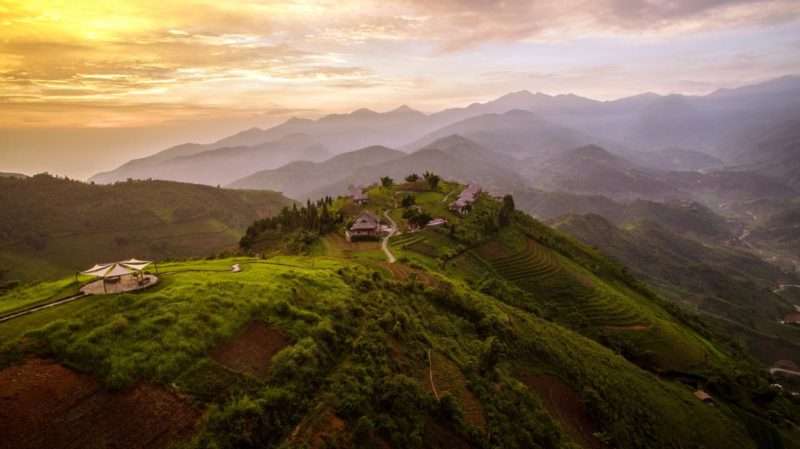
Topas Ecolodge
Check Prices on Booking.com
If you really want to treat yourself during your trip to Sapa, consider booking a few nights in the Topas Ecolodge. This stunning and unique resort is outside of the town and offers absolutely breathtaking views of the rice terraces from your comfortable room and from the pristine outdoor pool. It’s a great way to pamper yourself and an experience that you’ll never forget!
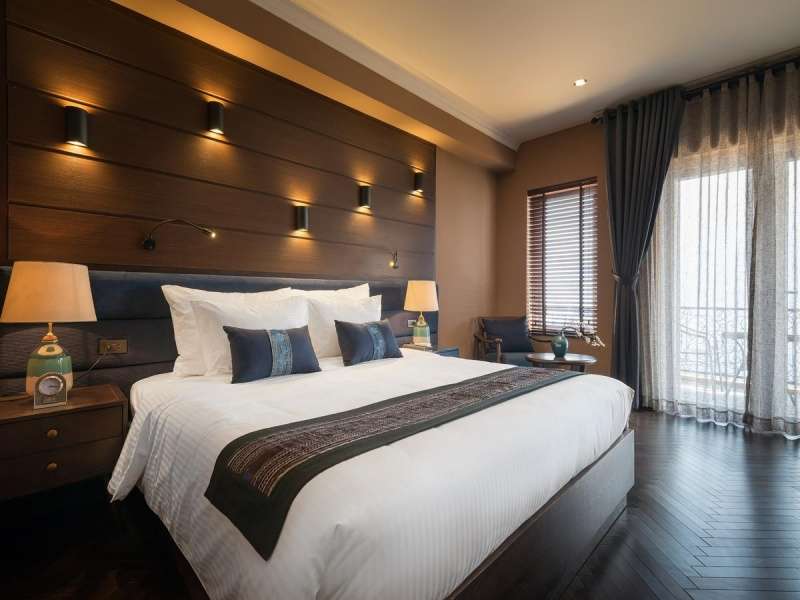
Aria Boutique Sapa Hotel & Spa
If you’re looking for luxury accommodations, then Aira Boutique Sapa Hotel & Spa is the perfect getaway during your vacation in Sapa! Featuring spectacular views of the valley, a gorgeous outdoor pool, a state-of-the-art gym, and beautifully decorated rooms – you’ll enjoy all of the comforts of home here.
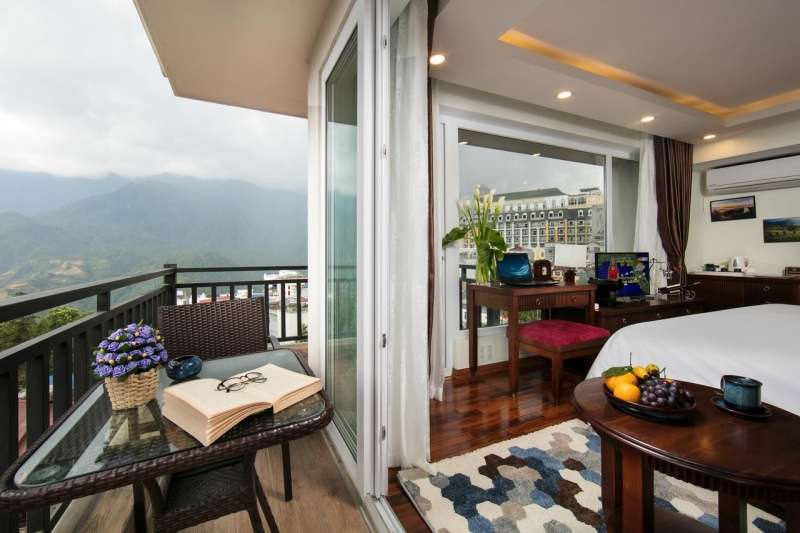
Sapa Horizon Hotel
If you still crave luxury but want a more modest price point, consider booking a room at the Sapa Horizon Hotel. You’ll love the ultra-comfortable bed that you can sink into after a long day of trekking. And the delicious breakfast is the perfect way to start every day in Sapa!
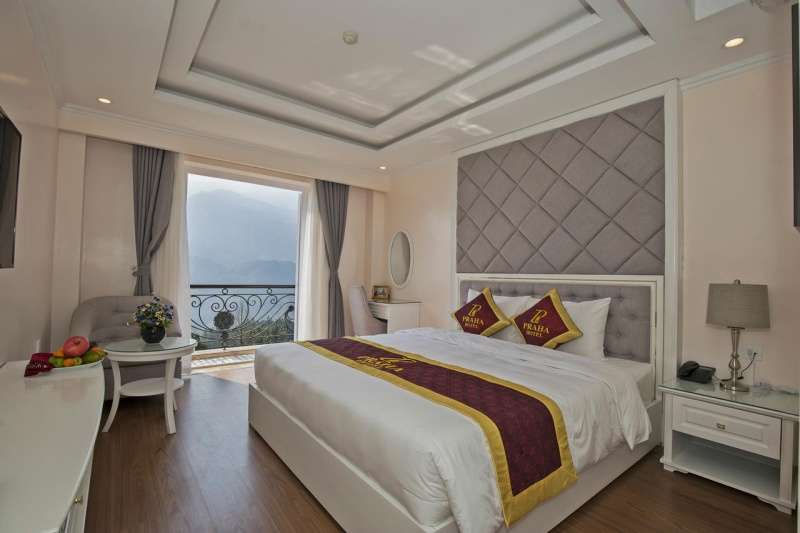
Praha Hotel Sapa
An even more budget-friendly accommodation in town is the Praha Hotel Sapa. You can get really reasonably priced rooms or pay a bit more for a lovely private balcony overlooking the valley. The rooms are spacious and clean and the staff is so friendly!
Where to Eat in Sapa
We found the dining options in Sapa to be, well, pretty much all the same. Most of the restaurants offer similar cuisine options, including typical Vietnamese classics, hamburgers, and pizza. None of them are necessarily bad, but you probably won’t be raving about the food scene in Sapa when you leave. These two were our favorites:
- Fansipan Terrace Cafe offers really beautiful views of the valley, a peaceful garden for relaxing, and yummy, reasonably priced dishes. Spend a few hours here sipping hot wine and enjoying the view!
- La Roma Pizza has mediocre reviews on Tripadvisor which is a mystery to me because the barbeque chicken pizza is surprisingly delicious (especially for Asia). Plus, they offer a free beer and an order of garlic bread with every pizza!
Where to Drink in Sapa
Hot wine is the classic alcoholic beverage in Sapa. You’ll find restaurants serving different variations of it all over town.
AD
- Le Gecko Cafe is a cute little French restaurant with a prime location right on the lake. It’s a lovely place to enjoy a glass of hot wine, a tasty dessert, and watch the sun go down.
- H’mong Sisters is probably the most popular hangout in town. At least, that’s what was recommended to us by the locals.
- The Hill Station is a chain so you might spot them all over Vietnam. You can trust that every location will have a lively atmosphere and really good craft beer.
- Luckydaisy’s Bamboo Bar is actually located down the hill from Sapa in the village of Tả Van. If you happen to be staying in Tả Van, this is the perfect place to relax with a cup of hot chocolate or hot wine.
Villages Near Sapa, Vietnam
If the town of Sapa sounds too touristy for your liking, there are several other smaller villages nearby as well. They are just beginning to build their tourism infrastructure so roads aren’t as good, homestays can be lacking in luxuries, and restaurant options are a bit limited. But you’ll probably feel like you’re having a more “authentic” experience!
Lao Chải Village
Lao Chải village is just about four miles east of Sapa town. The locals here are referred to as “black Hmong” as their traditional clothing is thick jackets that have been dyed black from indigo. Many of the homestays in this village are not yet available to book online. You may want to go without a reservation and check out your options when you get there. If that makes you nervous, Eco Palms House is a good choice.
Tả Van Village
Tả Van village is about a 45-minute drive from Sapa town and is another more laid-back area to stay in. The Giáy people own most of the restaurants, shops, and homestays, but the Hmong people live further up the mountain and hike down to peddle their wares. We really enjoyed staying at the “Salem Homestay” but the owner doesn’t speak English and the property is not yet online (but they do have Facebook!). If you’d prefer to book in advance, Mountain River Homestay is a lovely choice.
AD
The taxi ride to Tả Van village will cost about 200,000 VND for two people or 250,000 VND for four. But keep in mind that the road may be impassable if there have been heavy rains.
Giàng Tả Chải Village
Giàng Tả Chải is the next village down the valley from Tả Van. If you are staying in Tả Van, it’s an easy 2.5-mile walk down to Cau May waterfall situated at the base of Giàng Tả Chải. There are also a few homestays in Giàng Tả Chải but very little else in terms of bars or restaurants.
Trekking in Sapa, Vietnam
Trekking is the number one activity to do while visiting Sapa and there are several areas that you can visit. You can opt for self-guided tours but you risk getting hounded the whole way by Hmong women who will walk alongside you for what feels like forever in the hopes that you eventually relent and browse their goods. A guide will keep them at bay. Plus you’ll get to learn from a local!
Self-Guided Sapa Treks
Trek to Cat Cat Village from Sapa Town
If you would prefer to do a self-guided trek, Cat Cat Village is only 1.15 miles from Sapa town and is downhill for most of the way. Your walk will begin on the road but the road ends shortly after the ticket booth (you’ll need to pay 70,000 VND/person) before you begin walking on a well-maintained stone path.
You’ll pass several cute coffee shops and restaurants along the way, perfect to take a break and enjoy the views. When you reach the bottom of the valley, you’ll come across a row of water wheels, two picturesque bridges, and the impressive Cat Cat waterfall.
If you continue on up the stairs across the bridge, you’ll have a steep climb but you can turn the trek into a loop. Shops selling souvenirs line each side of the stone stairs. There are also several motorbikes waiting to take you back up to town if you’d prefer not to walk. Expect to pay around 30,000 VND for a motorbike ride back to Sapa.
Trek to Tả Van Village from Sapa Town
Many people hire a guide to hike to Tả Van village. You can take the main road all the way there (although it won’t be a very nice walk as there the road is heavily trafficked). Another option is to cut off to the pedestrian trail on the side of the mountain. The turnoff to the trail can be hard to spot but dozens of Hmong ladies lead groups that way every morning around 9 am. You can just linger nearby and watch where they go.
AD
You’ll have gorgeous views of the valley and the river below for the entire length of the trek. And once you arrive at the village at the bottom, you can either walk back up or hire a motor taxi to take you back to Sapa
Guided Treks Around Sapa
How to Choose a Tour Guide
There is no need to book a tour in Hanoi unless you specifically want to. You will be surrounded by Hmong women offering you their tour guiding services as soon as you get off the bus. As well as daily when you’re wandering around town. Keep in mind that you’ll be spending several hours or days with your guide. Choose someone that is easy to communicate with and not too pushy. Don’t feel pressured to choose a guide on the spot.
Get Your Guide also offers tours of the Sapa Region, some including transfers directly from the city of Hanoi. If you’d prefer to have a tour agency take care of all of the logistics for you, it’s a simple and cost-effective way to visit Sapa, Vietnam.
Choosing a Tour of the Sapa Region
Once you give your guide the details of the kind of trekking that you’d like to do, they will determine what villages you will visit and where you will stay.
Our Trekking in Sapa Experience:
Our trekking tour was 2 days/1 night. On the first day, we trekked 12 miles and much of the beginning was uphill so it was quite difficult. We had stunning views from the top and didn’t see any other tourists until we reached a small town where we ate lunch. Then we trekked all the way back down to Giang Ta Chai village where our homestay was right near a beautiful waterfall.
On our second day, we were sore from so much walking the day before, so we took a motorbike tour of the region that lasted about 3.5 hours. Everything was organized by our amazing guide, A Hang Thi.
Cost of Trekking in Sapa
If you book a tour ahead of time, you’ll pay around $25-40 per person per day depending on the length and difficulty. If you go for only one day, that price includes two meals. If you go for two or more days, the price will include the cost of your homestay and meals.
If you book a tour from one of the Hmong ladies around Sapa town, you can negotiate the price but you’ll likely end up paying around $20-30 per person per day. That should also include meals and homestay but you should confirm in advance.
Tipping Your Sapa Tour Guide
Tip (or don’t tip) your guide, it’s up to you. They don’t necessarily expect it but appreciate it of course. The locals in Sapa receive very little help from the government. They rely heavily on tourism to survive so if you can give them a few extra dollars, it goes a long way. A tip of 100,000 VND per person is pretty standard. If you are really happy with your guide, you are always welcome to give more.
